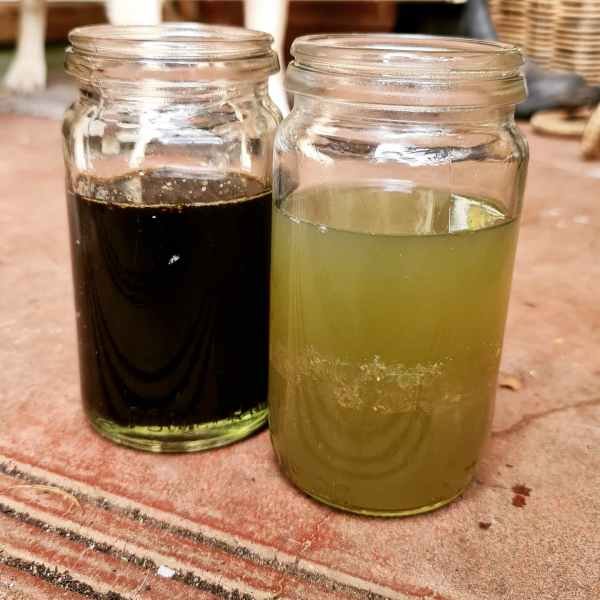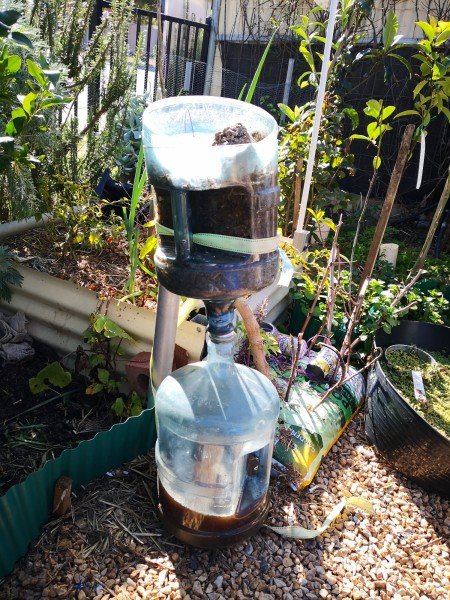Occasionally, usually on a quiet Wednesday, I'll post same tips and techniques from Ligaya Garden. Here's the first and it's about liquid gold - Activated Compost Teas.

Compost teas are easy to make and simple to apply. They are really just a brew of nutritious organic materials that are diluted and either sprayed as foliar sprays or added to the soil at the root zone.

To make them extra potent, a compost tea aerator can continuously mix the ingredients by bubbling air through the solution. This also gives a boost to the beneficial microbes that will break down the components of the tea into forms that are more accessible to the plants. It helps reduce the time required to make the tea drastically.
Any organic material that can be added to a compost heap can be used. Here’s a few of my favourite ingredients –
- Worm castings
- Nettles
- Yarrow
- Comfrey leaves
- Chicken poo
- Molasses
- Bokashi liquid (from the bottom of the Bokashi bin, not the stuff you spray onto the veggie scraps)
- Dolomite
All of these are well known composting ingredients that are easy to source.
Worm castings are a cornerstone of all of my compost teas. They are well known for their amazing range of plant nutrients. Nettles too have a formidable reputation for their nutritional content and make a well known tea in their own right.
Yarrow and Comfrey are known as ‘compost activators’. they have compounds in them that help speed the composting process through enhancing biological or chemical reactions in the compost pile. Comfrey is a dynamic accumulator and contains valuable potassium.
Chicken poo is a well known fertilizer that is full of nitrogen. That nitrogen boosts microbial activity quite well. We get pigeon poo from a free local source and that helps to add phosphorus to the mix.

Molasses gives a food source to micro-organisms. This isn’t highly beneficial in the soil, as it does cause quick spikes in the microbe population that it feeds but these populations crash when this easy food source is used up. For our purposes though, it can increase microbe activity during the relatively short time we’re making the tea and help break down the organic materials into substances that can be more readily uptaken by the plants or soil biota.
Bokashi liquid adds a whole heap of new microbes to the mix. Even though the Bokashi process is anaerobic, if it is exposed to air for a whiHeader 5le, it becomes colonized by aerobic microbes that use it as a food source.
Dolomite or rock dust has some minerals in it, but I mostly add it to the mix if it is too acidic.
Ligaya Garden's secret brew -
For a compost tea activator , I use a 60 litre bin. To this I add -
- 300g worm castings
- 100g Nettle leaves
- 100g chicken or pigeon poo
- 1 cup molasses
- 1 cup Bokashi liquid
- a good handful of Comfrey or Yarrow depending on how much is growing in the garden
- usually a small handful of dolomite
- sometimes a splash of urine if I’m feeling daring.
These ingredients are added to 60 litres of rainwater and put into the compost tea brewer where air is bubbled through for 10 minutes every hour, allowed to rest and bubbled again and the process is repeated a few times throughout the day. It is then ready to go after filtration. Put the waste from the filtering straight onto your compost heap. You can bubble yours for longer if you want, but 10 minutes is the limit for my old, roadside bounty compressor before it starts to overheat.
You can see from the ingredients that I reckon that the microbial population and activity is the prime driver of a good compost or tea but be creative with your mix, there are hundreds of ideas online. You can even just get existing compost and soak it in water for a couple of days before straining it and using the resulting liquid.
It’s that easy!






